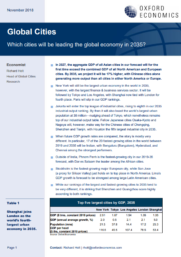
Which cities will be leading the global economy in 2035?

In 2027, the aggregate GDP of all Asian cities in our forecast will for the first time exceed the combined GDP of all North American and European cities. By 2035, we project it will be 17% higher, with Chinese cities alone generating more output than all cities in either North America or Europe. New York will still be the largest urban economy in the world in 2035, however, with the largest finance & business services sector. It will be followed by Tokyo and Los Angeles, with Shanghai now tied with London for fourth place. Paris will slip in our GDP rankings. Jakarta will enter the top league of industrial cities, rising to eighth in our 2035 industrial output ranking. By then it will also boast the world’s largest urban population at 38 million––nudging ahead of Tokyo, which nonetheless remains top of our industrial output table. Fellow Japanese cities Osaka-Kyoto and Nagoya will, however, make way for the Chinese cities of Chongqing, Shenzhen and Tianjin, with Houston the fifth largest industrial city in 2035. When future GDP growth rates are compared, the story is mostly very different. In particular, 17 of the 20 fastest-growing cities in the world between 2019 and 2035 will be Indian, with Bengaluru (Bangalore), Hyderabad, and Chennai among the strongest performers. Outside of India, Phnom Penh is the fastest-growing city in our 2019-35 forecast, with Dar es Salaam the leader among the African cities. Stockholm is the fastest-growing major European city, while San Jose (a proxy for Silicon Valley) just holds on to top place in North America. Lima’s GDP growth is forecast to be strongest among large Latin American cities. While our rankings of the largest and fastest-growing cities to 2035 tend to be very different, it is striking that Shenzhen and Guangzhou score highly according to both rankings.
- Issues:
- Demography, Urbanization and Migration, Economics
- Regions:
- Asia, Europe, Global, North America
- Year Published:
- 2018
- Institution:
- Oxford Economics

